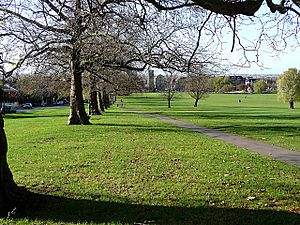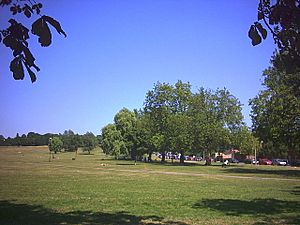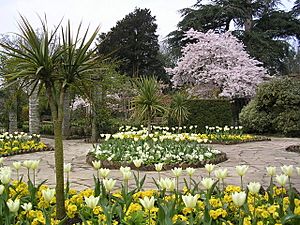Streatham Common facts for kids
Streatham Common is a big open space in South London. It's located on the southern edge of Streatham in the London Borough of Lambeth. The lower, western part of the Common has lots of mowed grass. The upper, eastern half is mostly woodland. It also has some small areas of gorse bushes and acid grassland. This eastern woodland part is so special that it has been named a Local Nature Reserve. This means it's protected for its wildlife and plants.
A Look Back: Streatham Common's History
Streatham Common is one of two large areas of shared land from the old Streatham parish. The other one is now known as Tooting Bec Common. In 1883, after some land changes, the Common was bought. It was purchased to be a public open space for everyone to enjoy. This was done using a special law called the Metropolitan Commons Act 1878. Around this time, most of the trees along the edges of the lower common were planted.
The Common was then given to the Metropolitan Board of Works. Later, the London County Council and Greater London Council looked after it. Since 1971, the London Borough of Lambeth has been responsible for its care.
Cricket has been played on the Common for a very long time, since the 1700s. The right to play cricket there is even written into the law that made the Common public.
Some famous people have lived near Streatham Common. Thomas Ripley, a well-known architect, built and lived at 10 Streatham Common South. This house is now called Ripley House. Henry Tate, who started the Tate Gallery and the Tate & Lyle sugar company, lived at Park Hill, which is also by the Common.
The Rookery: A Special Garden
Next to the historic Common is a beautiful formal garden called The Rookery. This garden used to be the grounds of a large house. Visitors came to this house to use one of Streatham's old mineral wells.
The Rookery is famous for its very old cedar trees in the main garden. There is also a rock garden with a small waterfall. Below the waterfall is a water garden with giant Gunnera plants. Parts of the old kitchen gardens have been turned into a series of walled gardens. These include an Old English Garden and a White Garden. This White Garden was created even before the more famous one at Sissinghurst Castle.
The rest of the old kitchen gardens were once used to grow plants for the council. After being left empty for 20 years, they are now managed by Streatham Common Community Garden. Here, local people grow food together. These gardens are open to the public on most Sundays.
The Rookery and the nearby Hilly Four Acres field were bought by public donations in 1911. This saved the land from being built on with houses. It was given to the London County Council and opened as a public park in 1913. The south-east end of Streatham Common and The Rookery touch Norwood Grove. This area is in the London Borough of Croydon. In 1923, the group that bought The Rookery came together again. They saved Norwood Grove from being developed. Now, there is almost a continuous line of green spaces from Streatham to Crystal Palace.
The gently sloping lawns of The Rookery are used as an open-air theatre in the summer.
How Streatham Common is Managed
A group called the Management Advisory Committee (MAC) was started in 1996. This group created a plan for looking after Streatham Common and The Rookery. This led to the nature reserve being created and detailed plans for managing its habitats. A separate group, Friends of Streatham Common, helps organize events on the Common and in The Rookery. This includes a very popular annual kite festival. Since 2011, the Friends group has taken over the MAC's work.
The Streatham Common Co-operative (SCCoop) was set up by members of the Friends group. Their goal was to manage the Common locally. This would make sure local people had more say than big borough-wide park contracts. After several years of planning, SCCoop took over managing The Rookery in 2015.
When budget cuts by Lambeth Council threatened to close the paddling pool, SCCoop stepped in. They agreed to manage the pool from Summer 2016 and raise money for it. In 2017, SCCoop also started doing conservation work in the nature reserve parts of the Common.
The London Wildlife Trust is currently working with Lambeth Council and the Friends of Streatham Common. They are trying to make the site even better for wildlife. This is part of The Great North Wood Project.
In 2010, Streatham Common was saved from a plan to build a "temporary" ice rink there. This was while Tesco redeveloped the old Streatham ice rink. A strong local campaign, called 'Hands Off Our Common', helped stop this.




